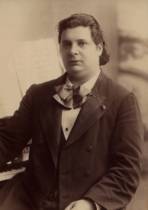
Eugène Ysaÿe (July 16, 1858 – May 12, 1931) was a Belgian violinist, composer and conductor. Born in Liège, Belgium, Ysaÿe began violin lessons at age five with his father. He would later recognize his father's teaching being the foundation of everything he knew on his instrument, even though he went on to study with more reputable masters. At age seven he entered the Conservatoire at Liège studying with Joseph Massart, though soon afterwards he was asked to leave the conservatory because of lack of progress. This was due to the fact that young Eugène in order to support his family had to play full time in two local orchestras, one conducted by his father. Eugene went on playing in these ensembles, though he studied by himself and learned the repertoire of the violin. By the time he was twelve, he was playing so well that one day he was practicing in a cellar when the legendary Henri Vieuxtemps walked by on the street and was so impressed with the sound of his violin and took interest on the boy. He arranged for Ysaÿe to be re-admitted to the conservatory studying with Vieuxtemps's assistant, the noted Henryk Wieniawski. Ysaÿe would later also study with Vieuxtemps, and both "master and disciple", as Ysaÿe would call the roles of teacher and pupil, were very fond of each other. In his last years, Vieuxtemps asked Ysaÿe to come to the countryside just to play for him. Studying with these teachers meant that he was part of the so-called Franco-Belgian school of violin playing, which dates back to the development of the modern violin bow by François Tourte. Qualities of this "École" included elegance, a full tone with a sense of drawing a "long" bow with no jerks, precise left hand techniques, and bowing using the whole forearm while keeping both the wrist and upper arm quiet (as opposed to Joseph Joachim's German school of wrist bowing and Leopold Auer's Russian concept of using the whole arm.) After his graduation from the conservatoire at Liège, Ysaÿe was the principal violin of the Benjamin Bilse beer-hall orchestra, which later developed into the Berlin Philharmonic. Many musicians of note and influence came regularly to hear this orchestra and Ysaÿe in particular, among whom figured Joseph Joachim, Franz Liszt, Clara Schumann, and Anton Rubinstein, who asked that Ysaÿe be released from his contract to accompany him on tour. When Ysaÿe was twenty-seven years old, he was recommended as a soloist for one of the Concerts Colonne in Paris, which was the start of his great success as a concert artist. The next year, Ysaÿe received a professorship at the Brussels Conservatoire in his native Belgium. This began his career as a teacher, which was to remain one of his main occupations after leaving the Conservatoire in 1898 and into his last years. Among his more respected pupils are Josef Gingold, former concertmaster of the Cleveland Orchestra and Professor at Indiana University, the viola virtuoso William Primrose, the violin virtuoso Nathan Milstein (who primarily studied with Piotr Stolyarsky), Louis Persinger, Alberto Bachmann, Mathieu Crickboom, Jonny Heykens, Jascha Brodsky, and Aldo Ferraresi. During his tenure as professor at the Conservatoire, Ysaÿe continued to tour an ever-broadening section of the world, including all of Europe, Russia, and the United States. Despite health concerns, particularly regarding the condition of his hands, Ysaÿe was at his best when performing, and many prominent composers dedicated major works to him, including Claude Debussy, Camille Saint-Saëns, César Franck, and Ernest Chausson. In 1886 he established the Ysaÿe Quartet, which premiered Debussy's String Quartet. As his physical ailments grew more prohibitive, Ysaÿe turned more to teaching, conducting and an early love, composition. Among his most famous works are the six Sonatas for Solo Violin op. 27, the unaccompanied Sonata for Cello, op. 28, one Sonata for Two Violins, eight Poèmes for various instruments (one or two violins, violin and cello, string quartet) and orchestra (Poème élégiaque, Poème de l'Extase, Chant d'hiver, Poème nocturne, among others), pieces for string orchestra without basses (including Poème de l'Exil), two string trios, a quintet, and an opera, Peter the Miner, written near the end of his life in the Walloon dialect. Ysaÿe had been offered the post of music director of the New York Philharmonic in 1898, but declined it due to his busy solo performance schedule. In 1918, he accepted the music director's position with the Cincinnati Symphony Orchestra, where he remained until 1922 and with which he made several recordings. Finally, in 1931, suffering from the extreme ravages of diabetes that had necessitated the amputation of his left foot, Eugène Ysaÿe died in his house in Brussels and was interred in the Ixelles Cemetery in Brussels.
Mendelssohn: 'Ein Sommernachtstraum' Scherzo
Offenbach: 'Orfeo all'Inferno' Ouverture
Rimsky-Korsakov: Scheherazade (two excerpts)
Chabrier: Marche joyeuse
Delibes: 'Naila' Intermezzo
Maillart: 'Les Dragons de Villars' Ouverture
Massenet: 'Le Cid' Navarraise
Cincinnati Symphony Orchestra Eugene Ysaye
Rec.: 28.11.1919
|

